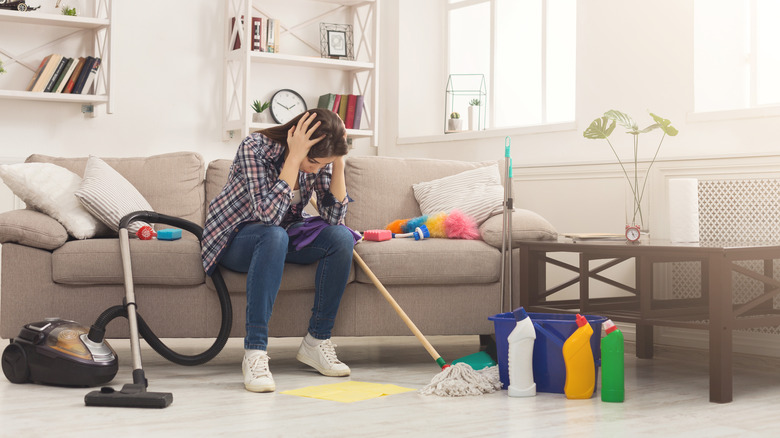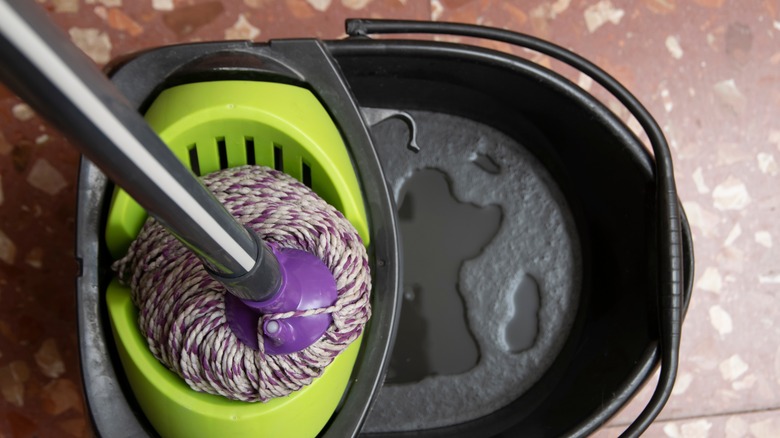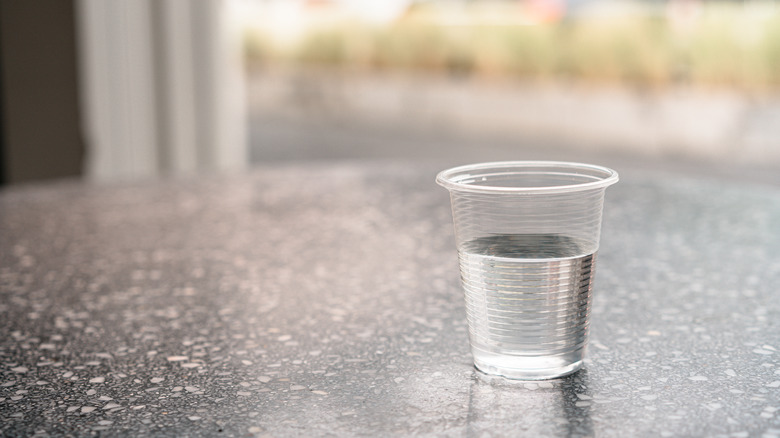The Big Mistake Everyone Makes When Cleaning Terrazzo Flooring
We may receive a commission on purchases made from links.
No one likes the look of stained, dusty, or dull terrazzo flooring. Homeowners, hoteliers, and office building developers choose it for its brilliant shine, low-maintenance nature, and quirky, often colorful patterns. In an effort to restore its luster, people turn to tried-and-true acid or alkali cleaners — think cheap all-purpose cleaners, grout cleaners, or even baking soda and kitchen vinegar. This is — if you haven't guessed from the title of this article — a mistake. These solutions might get luxury vinyl or ceramic tiles spick and span without harm, but they damage the specific natural and synthetic materials terrazzo floors are crafted from.
Terrazzo flooring has a rich history in Italy that dates back centuries. For a long time, it had a reputation as a cheap alternative to marble or natural stone floors. Today, that perspective has shifted, and it's now seen by interior designers as a way to add some midcentury flair to a home or office. A binding medium — traditionally cement or, since the 1970s, epoxy resin — is poured around chips (called aggregate) of marble, stone, or more luxurious materials like crushed pearl on the floor. You can also buy factory-fabricated terrazzo tiles. The floor is sectioned off using thin strips of metal to avoid cracking. The aggregate is usually stain-resistant; the material holding it in place is prone to damage if not cared for correctly.
Clean science
How do you care for terrazzo flooring when it comes to cleaning? Experts advise homeowners to use pH-neutral cleaners on their terrazzo floors. The term "pH" represents how concentrated hydrogen (versus hydroxide) ions are in any given solution. Solutions with a neutral pH rank around 7 — give or take — on a scale that runs from 1 to 14, meaning an equal ratio of hydrogen and hydroxide ions. For example, the U.S. General Services Administration recommends using "mildly abrasive phosphate-free" cleaners with a "pH factor between 7 and 10" when cleaning terrazzo floors in heritage buildings.
Acidic cleaners, including vinegar, reduce the shine of your terrazzo flooring, etch it, or, in the worst cases, eat away at the calcium-based marble chips. Bleach damages the polish applied on top of the flooring system, leaving dull patches. Alkaline cleaners — like chlorine bleach, baking soda, ammonia, and bathroom, grout, and tub cleaners — are just as harmful. They're absorbed by the porous terrazzo materials, where they slowly eat away at them, discolor the terrazzo, or leave behind an unseen residue that attracts rather than repels grime. Avoid using most, if not all, all-purpose cleaners, too — especially those with water-soluble inorganic or crystallizing salts.
The how-to
Most cleaners need to be diluted before use; how much varies between manufacturers and brands. Always follow the manufacturer's instructions, as too-concentrated solutions may damage natural or synthetic flooring materials. 3M™ Neutral Cleaner Concentrate comes in a 64.2-ounce bottle. Buy it at Walmart for $47.72. Amazon sells tubs of Easy Paks Neutral Cleaner — which consists of powdered cleaner packets you dilute in water — for $41.18. This product is formulated for use on terrazzo. You can make a simple terrazzo floor cleaner by mixing alcohol, dishwashing liquid, and water, or even just dish soap and water. In fact, plain water will often clean terrazzo floors just fine! Keep in mind, however, that the minerals and heavy metals in hard tap water can damage this type of flooring. If you have hard water, use filtered water instead.
Cleaning specialists can also try to find cleaners with calcium magnesium acetate as their active ingredient. It's an environmentally and natural materials-friendly salt. Treat stubborn stains with a 3:1 ratio of water to glycerin. Rinse the area well with clean water after wiping off the treatment or risk a scratched surface later. Alternatively, be diligent. Blot up spills immediately with a cloth or paper towel. Then, you won't have to work out how to remove stains at all. If you're using a steam cleaner, get one that doesn't use detergent, and never use hard-bristled scrubbing brushes or scouring pads on terrazzo. Perhaps unsurprisingly, they leave gouges and scratches with each pass over. Soft-bristled brushes or microfiber cloths work best.


